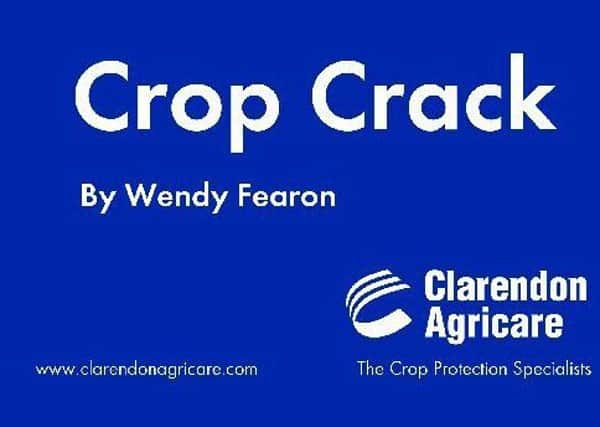Winter barley crops looking well in the fields


Most winter wheat crops have received their T3 earwash with a few later drilled crops still to be sprayed.
Tebuconazole is the most effective triazole for Fusarium in particular and an important active in its own right at this time.
Advertisement
Hide AdAdvertisement
Hide AdThe addition of a strobilurin is essential to maximise the persistence of the triazole, to strengthen activity on Yellow Rust, and delay early leaf senescence.
Good grain fill is totally dependent on retaining green leaf area for as long as possible, and the addition of the strobilurin extends the retention of green leaf tissue.
ADHB trials continue to show pyraclostrobin (COMET) to be the highest rated strob for use in wheat, being the strongest performer on Yellow rust and the late ear diseases.
Aphids in cereals
As the grains begin to fill the aphids begin to feed at its base on the ear, drawing off the sugars that should be filling the grain if left unchecked.
Advertisement
Hide AdAdvertisement
Hide AdGrowers need to continue checking crops for aphids right up to early milky ripe stage (GS73) in barley, late milky ripe (GS77) in wheat, and spray if present in numbers.
Where aphids are not present, unnecessary application should be avoided as any insecticide application at this time is not bee friendly.
Of the aphicides approved for use for this purpose, SUMI-ALPHA is the least harmful to bees.
Pre Harvest Glyphosate
Winter barley crops are ripening well and thoughts will now turn to grain quality, moisture levels, and ease of harvesting.
Advertisement
Hide AdAdvertisement
Hide AdPre harvest application of glyphosate is an essential tool to improve the efficiency of harvesting, giving a range of benefits.
Harvest management
Independent trials carried out over a number of years in GB, looking at the effect of using Roundup in various replicated treatments consistently show moisture contents being reduced by 2.0-2.5% at harvest compared to plots where no treatment is applied.
With a wide range of glyphosate products available, which offers the best performance in the field, and best value for money?
First off, it is not the price per drum that should be compared.
Advertisement
Hide AdAdvertisement
Hide AdWith different formulation types having different strengths of active per litre and therefore different rates of use, it is the price per acre treated that should be compared and the level of performance is being obtained from each.
Glyphosate itself is not very soluble, therefore it depends very much on the salts and wetter’s to enhance its performance.
The potassium salt in Roundup Energy is taken up significantly faster than isopropylamine salt; as a result ENERGY is rainfast within one hour of application and cultivation can commence as soon as two days after application whereas the IPA glyphosate products need a minimum of six hours to be rainfast and five days minimum before cultivating.
Application should be made once the grain moisture gets down to 30% or below, ideally 10-14 days (and not less than seven days) before cutting.
Advertisement
Hide AdAdvertisement
Hide AdAn easy and reliable test to estimate this 30% moisture level is to press the thumbnail into a number of grains; if the indentation holds on all the grains the crop is ready for spraying.
Potatoes
As canopies close, the soil surface will tend to remain damper, encouraging slugs onto the soil surface.
Timing is critical for effective control, just before the crop meets across the rows.
Take advantage of any rainfall by applying pellets just afterwards, as this will bring slugs up onto the soil surface.
Advertisement
Hide AdAdvertisement
Hide AdPotato varieties particularly susceptible to slug damage include Maris Piper, Desiree and Kerrs Pinks.
Blight fungicides move through the plant in three different ways contact, translaminar and systemic. Dithane, Ranman Top, Shirlan and Tizca are all contact fungicides.
These products protect only the outer surface of the leaf onto which they are deposited.
Translaminar products such as Curzate M, Invader, and Revus move into the leaf and redistribute throughout the leaf tissue as it increases in size whilst systemic products such as infinito move in through the leaf surface and upwards into the new growth protecting this from infection also.
Advertisement
Hide AdAdvertisement
Hide AdProducts that have zoospore activity are the most effective first spray, applied at the rosette stage prior to rapid haulm growth. Shirlan or Tizca will control any zoospores that may be in the soil and provide good protection of the new plant.
During the main canopy development phase with the considerable amount of new growth it is essential the product being used is fully systemic to properly protect the new leaves, being put on between applications.
Later planted crops are at higher risk as they produce more new growth between applications than earlier drilled crops, at a time when the level of inoculum in the air is progressively increasing.
The way the blight product is applied is as important as the product choice.
Advertisement
Hide AdAdvertisement
Hide AdMake sure nozzle type used is correct to ensure sprayer pressure; droplet size and water applied is as directed on the label.
Inspect and calibrate nozzles regularly to maintain performance.
Never use any blight product at reduced rates .
Do not spray when the leaves are wet as this will significantly increase the likelihood of runoff.